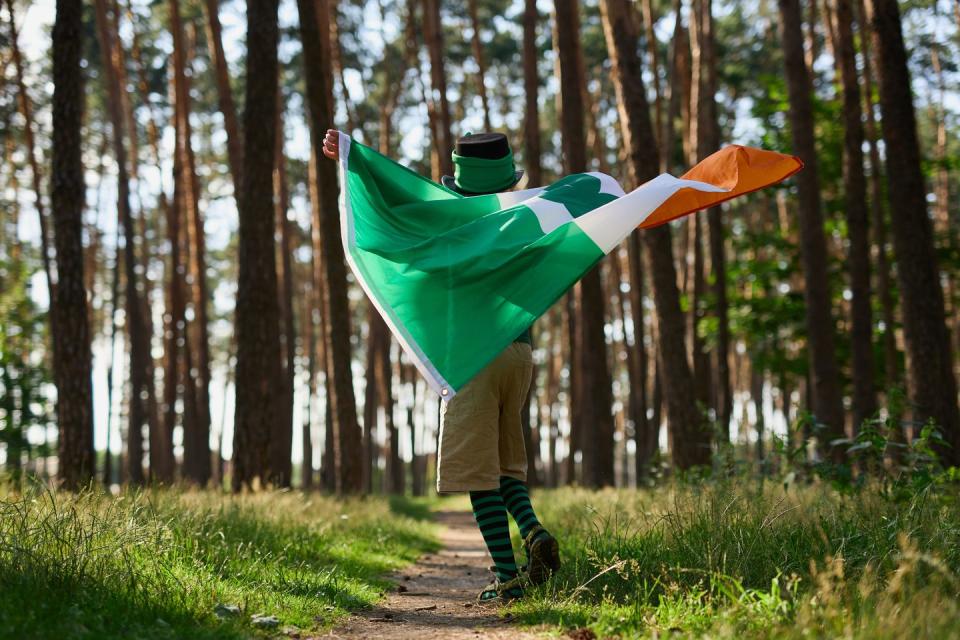Here's the Surprising History of St. Patrick’s Day, Including Why We Wear Green
- Oops!Something went wrong.Please try again later.
"Hearst Magazines and Yahoo may earn commission or revenue on some items through these links."
March is the ultimate season of green—for more reasons than one! Of course, we have budding trees and flowers to look forward to during the first month of spring, but there's another reason to embrace the color green during March: St. Patrick's Day! With the shining sun in the sky and parades bustling through the streets, St. Patrick's Day is a welcome respite from winter, filled glorious green attire. And that's not to mention the best St. Patrick's Day tradition of all: Eating all those green St. Paddy's Day foods! But before we get into the fun stuff, why not take the time to learn about the history of St. Patrick's Day? There's more to it than you may think!
Take the patron saint of Ireland, for example. Did you know he wasn't actually Irish? (Cue the gasps!) Or that St. Patrick's Day parades in the U.S. were originally a means for early Irish immigrants to show their collective pride? The events even attracted hopeful political candidates vying for the Irish-American voting block. You'll also be shocked to know that many meals made to celebrate the day in America aren't actually traditional Irish dishes. Though some things never go out of style on St. Paddy's Day, like delicious Irish desserts, reciting Irish blessings, and posting festive Instagram captions. 😂 But if you're interested in why we celebrate in the first place, take a quick journey into the history of this popular holiday. You might even watch a few Irish movies while you're at it—some of which will give you serious wanderlust to visit the Emerald Isle!
Ahead, you'll find the actual reason behind St. Patrick's Day, information on Saint Patrick himself, and why we associate the color green with the day. We've even gathered ideas to help you celebrate in the most traditional way. Sláinte!
What's the history behind St. Patrick's Day?

You're probably not surprised to learn that St. Patrick's Day hasn't always been a raucous affair, celebrated with huge parades and green beer. As the feast day of Saint Patrick, it was and still is a holy day in Christianity. The day was first established in 1631 as a modest religious holiday, and honoring Ireland's patron saint. Because it fell right in the middle of Lent, people began using it as a reason to celebrate and take a break from the restraints and abstinence of the period leading up to Easter. However, it didn't actually become a public holiday in Ireland until 1904!
The St. Patrick's Day celebrations we recognize today are actually a product of Irish immigrants in America. Parades sprung up in major U.S. cities in the 1700s, including Boston and New York City. As Irish populations grew in America, so did St. Patrick's Day festivities. During the 1900s, Americans on March 17 were wearing green clothes, eating corned beef and cabbage (despite it not being a popular dish in Ireland!), and attending massive parades across the country.
Who was St. Patrick?

Saint Patrick is the patron saint of Ireland, known for bringing Christianity to the country. He lived in the fifth century and was actually born in Roman Britain—not Ireland! When he was 16, he was captured by Irish raiders and was sent as a slave to present-day Northern Ireland where he became a shepherd, writes the BBC. He grew close to his Christian faith during these difficult years and then went on and spread Christianity to the Irish through baptism and confirmation.
Hundreds of years after his death, several legends became popularized about this religious figure. One of these includes the famous story of St. Patrick driving the snakes from Ireland. But the explanation for there being no snakes in Ireland is simply that there's never been snakes in Ireland!
Is St. Patrick's Day a religious holiday?
Given that it's named after a Saint, you're probably wondering whether or not St. Patrick's Day is a religious holiday. Although we typically celebrate St. Patrick's Day with a focus on Irish culture and heritage rather than its religious significance in America, the holiday has Catholic roots. So yes, St. Patrick's Day is a religious public holiday in Ireland and has been for over 1,000 years.
Across the pond, March 17 is a holy day of obligation for Irish Catholics, typically observed by attending mass in the morning. Of course, there's still room for typical St. Patrick's Day festivities—like dancing, drinking, and eating traditional Irish food—after church services conclude!
Why do we wear green on St. Patrick's Day?

Ireland wasn't always associated with the color green. Even though its lush hills would suggest otherwise, the Emerald Isle was actually once aligned with the color blue instead. When Henry the VIII claimed himself to be king of Ireland in the 1500s, his flag was blue, meaning that Ireland was also associated with the color. However, green was later used as the color of the flag in the Great Irish Rebellion of 1641 when the Irish fought against the English. Over the years, green became a national symbol of pride for Ireland.
Wearing green clothes became common in the U.S. at St. Patrick's Day parades and celebrations in the 1800s. It was a symbol that Irish-Americans used to honor their heritage and seems to have stuck all these years later.
What food is eaten on St. Patrick's Day?

When you think of St. Patrick's Day foods, you probably think of corned beef and cabbage with a pint of green beer! While there's nothing wrong with indulging in that meal come March 17, it's actually more of an American-Irish tradition that you won't find in Ireland. So, what are some traditional Irish foods?
Similar to corned beef and cabbage is the authentic pairing of Irish bacon and cabbage. This traditional dinner is commonly served with a side dish of colcannon, or Irish mashed potatoes mixed with cabbage. Another popular meal for the holiday is Irish stew! Originally made with mutton, you'll now find the hearty dish made with slow-cooked beef or lamb—and veggies like carrots and potatoes. Roasts, shepherd's pie, and Irish soda bread will also make great additions to your St. Paddy's Day party.
As for St. Patrick's Day drinks and desserts, many Irish people will celebrate with several rounds of Guinness or Jameson Irish whiskey before topping off the meal with apple cake or Guinness brownies.
What do leprechauns have to do with St. Patrick's Day?

What if we told you that leprechauns technically "existed" before St. Patrick's Day even came to be?
That's right! Leprechauns were initially written about in 19th-century Irish fables. They were described as short men who just happened to be exceptional shoemakers. After making their money, they hid their coins in pots of gold at the end of rainbows. Fun fact: they weren't originally described as wearing green, but red instead!
Leprechauns weren't associated with St. Patrick's Day until recently. In 1959, Darby O'Gill and the Little People was released, a Disney film about an old Irish man and his leprechaun friends. The movie was released right as St. Patrick's Day parades were becoming more common. So, it just happened naturally: Leprechauns became a staple in St. Patrick's Day festivities.
You Might Also Like
